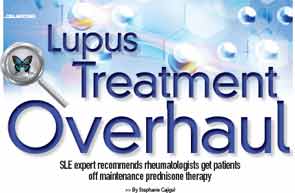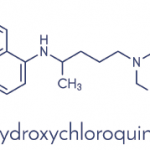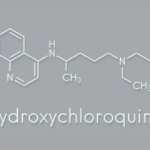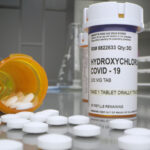
SANTA MONICA, CALIF.—The drug prednisone is a major problem in the treatment of systemic lupus erythematosus (SLE), disease expert Michelle Petri, MD, MPH, said here on May 19 at the California Rheumatology Alliance 9th Annual Medical and Scientific Meeting.
“I say the p in prednisone stands for poison, so that if I’m giving a lecture or general grand rounds, the primary care doctors will hopefully remember just that one point. But we have to remember it, too,” said Dr. Petri, professor of medicine and director of the Lupus Center at Johns Hopkins University School of Medicine in Baltimore.
Dr. Petri pointed out that musculoskeletal is the most common organ system to be damaged by corticosteroids in patients in SLE. Osteoporotic fractures are the most common musculoskeletal damage due to prednisone, followed by avascular necrosis. “Even if prednisone has short-term benefit, our patients are paying an unacceptable long-term cost,” she said.
Dr. Petri, acknowledged, however, that organ damage is multifactorial, with osteoporotic fractures, for example, partially explained by the vitamin D deficiency that is almost universal in lupus. She also pointed out that surveys have shown that many patients with SLE are taking proton pump inhibitors, which, according to warnings from the U.S. Food and Drug Administration, contribute to osteoporotic risk. These factors point to a multitude of things that rheumatologists must think about in order to reduce the long-term burden of osteoporosis, she said.
But, during her presentation, Dr. Petri repeatedly pointed out that the problem of long-term damage must first be addressed by a reduction in prednisone and emphasized that her goal is to redefine for practicing rheumatologists what “high-dose” prednisone means. She cited a study from 2009 in which she and colleagues concluded that “high-dose” prednisone should be defined as greater than 6 mg/day.1 The group prospectively followed 525 patients with incident SLE and reported the following hazard ratios of organ damage for prednisone as compared with no prednisone use:
- 1.16 for cumulative average doses >0–6 mg/day
- 1.50 for >6–12 mg/day
- 1.64 for >12–18 mg/day
- 2.51 for >18 mg/day
“You can see what happens with our lupus nephritis regimens, because in those regimens, everybody is going to be way above 18 mg, and that is going to lead to a 2.5-fold increase in organ damage,” Dr. Petri said.
HCQ Benefits
Throughout her presentation, Dr. Petri emphasized the benefits of hydroxychloroquine (HCQ) over prednisone; specifically, that it reduces flares, later renal and central nervous system damage, LDL cholesterol, and thrombosis.
Noncompliance, however, is preventing patients from fully taking advantage of these benefits, she said, noting a study by Nathalie Costedoat, MD, that reported that 50% of patients hospitalized for severe flare had a 0 blood level of HCQ.
Several studies show improved survival with HCQ, a message that should be communicated to patients at every visit, Dr. Petri said. “Neurologists do blood levels of all their antiepileptics quite routinely. I think we need to start to have blood levels of HCQ available to us as well, not so that we can yell at our patients, but so we can educate them,” she said
To reduce side effects, Dr. Petri recommends keeping the optimal dose of HCQ below 6.5 mg per kilogram and adjusting the dose downward if the patient has renal insufficiency, hepatic problems, or if they are elderly.
The Humphrey Visual Fields that rheumatoid arthritis–symptomatic patients on HCQ once received during their regular ophthalmology visits are now being replaced with ocular coherence tomography and electroretinograms. According to Dr. Petri, these high-tech scans are so sensitive that they pick up abnormalities that may have nothing to do with HCQ, such as a lupus retinopathy or a hypertensive retinopathy. The result is that patients are then being told by their ophthalmologist that the HCQ needs to be stopped.
“My view of this is that these tests should never be done in an asymptomatic patient who has a normal retinal exam and normal Humphrey Visual Fields,” she said. “If they are done and they are abnormal, I always ask that there be a second opinion given by the ophthalmologist at Hopkins, because we have no good replacement for antimalarials.”
Coronary Artery Disease
Dr. Petri also focused her presentation on how rheumatologists can improve coronary artery disease risk in patients with SLE. “This remains our main unmet need. This is the reason why survival in lupus patients has not improved since 1980,” she said.
Specifically, she recommended that rheumatologists aim for their patients to achieve normal blood pressures of 120/80 and LDL cholesterol levels of 100.
She also recommended a reduction in prednisone and described a study she just completed that found that in daily doses of 10 mg or higher, the drug was associated with a 2.4-fold increase in cardiovascular events as compared with controls.2
Give Burst Steroids a Try
Dr. Petri ended her presentation with an idea she hopes “will change your clinical practice right away.”
Since most SLE flares are mild to moderate, she suggested treating them with a burst of steroids, with either a medrol dose pack or triamcinolone 100-mg intramuscular, rather than with maintenance prednisone, similar to how neurologists treat multiple-sclerosis flares with steroids and then nothing.
Dr. Petri described the results of a clinical trial showing that patients experienced substantial improvement by days one and two after starting the therapy. By one month, the patients did not require rescue therapy. “Now if they had, we would have known they needed to start an immunosuppressant drug. If someone breaks through a burst of steroids, they’re telling you it’s not just a flare, they’re having some constant activity that needs to be suppressed,” she said, noting that triamcinolone injections should not be given more often than every three months.
Stephanie Cajigal is a medical journalist based in California.


